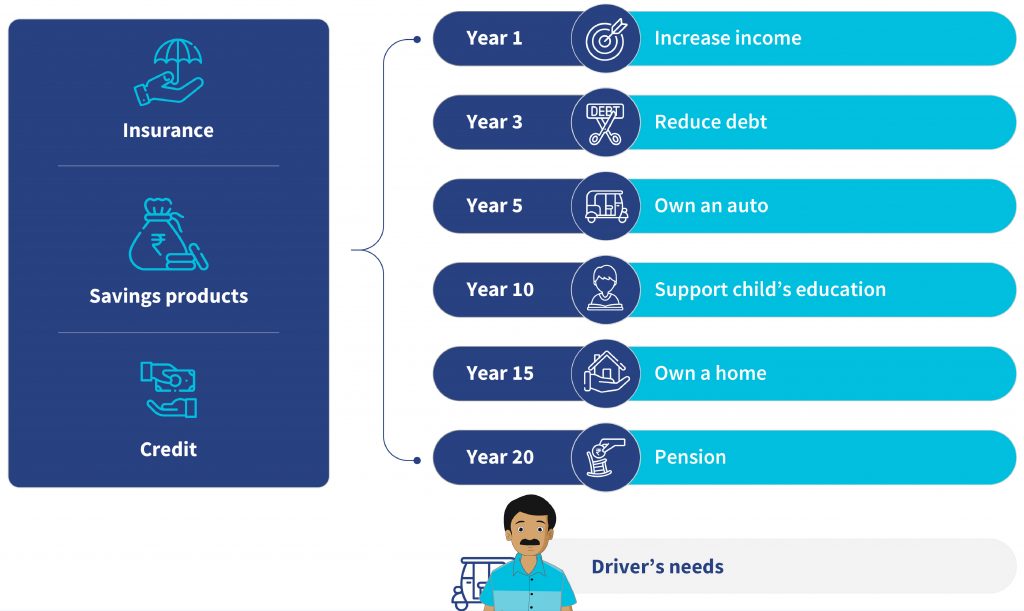Rydo: A ride with pride
by Shweta Menon, Nishant Kumar and Rutuja Jadhav
Jul 13, 2023
6 min
Rydo is a digital platform for auto-rickshaw drivers. It offers ride-hailing services in tier 1 and 2 cities and towns of India. It intends to improve mobility digitization in small towns with the power of ONDC. The blog describes how Rydo plans to use this digital transformation for the benefit of drivers to provide them with timely credit, easy repayment options, health coverage, and much more.
This blog is about Rydo, a startup in the Financial Inclusion Lab. The Lab is an accelerator program supported by some of the largest philanthropic organizations in the world, including the Bill & Melinda Gates Foundation, J.P. Morgan, Michael & Susan Dell Foundation, MetLife Foundation, and Omidyar Network.
“Rydo has helped me stand up on my feet again,” said Ravi beaming with happiness as he waited for his passengers to sit in his autorickshaw. Ravi used to drive a rented autorickshaw in Bengaluru, but when the pandemic hit, he had to return the vehicle and go back to his village near Tumkur—a district 70 km from the city. Once the pandemic was over, Ravi decided to rent another autorickshaw and drive in Tumkur, but his daily earnings were much less than he had hoped.
Sometime later, Ravi’s friend told him about a new ride-hailing service called Rydo that had launched in Tumkur. Earlier, Ravi had heard about his friends driving for Ola and Uber in Bengaluru and earning a good income. Ravi thought that Rydo seemed similar to Ola and Uber, so he decided to onboard.
Last-mile service providers, such as auto drivers, drive the paratransit space in India. But the current ride-hailing ecosystem offers them limited benefits. Rydo is a ride-hailing app that seeks to provide the best value to drivers by providing them with a better livelihood. It also improved the drivers’ access to financial services, such as credit and insurance.
The lightbulb moment
Rydo is the brainchild of Prakash and Vinay. Their common aspiration to work to uplift the society, brought them together. Prakash is an ex-banker, and Vinay is a Chartered Accountant. Both have more than two decades of experience.
They met at their previous workplace—a technology firm—and decided to build Rydo together. They started Rydo to boost entrepreneurship among low-income individuals by giving them suitable technology and financial support. The founders decided to focus on mobility, especially three-wheelers, due to the large market size, limited innovation in the sector, and ability to create a significant impact, especially in Tier-2 and Tier-3 towns and cities.
How does Rydo differ from the existing ride-hailing services?
Presently, ride-hailing technologies are not active in Tier-2 and Tier-3 cities since the average number of rides and the shorter distances do not suit their economics. Rydo can tap this opportunity to enter these 200+ cities and offer its services.
The founders launched Rydo in Tumkur, Karnataka, based on extensive research and market potential. The founders’ main goal is to mitigate the high wait time between rides, which leads to a loss of earnings for the drivers. They also want to provide affordable credit options to drivers based on their ride data.
As an alternative to the commission-based model of other ride-hailing apps, Rydo offers a subscription model where the platform enables drivers to accept rides and charges a fixed fee daily to remain on the platform. The subscription model helps attract more drivers, especially those who initially resisted onboarding to ride-hailing platforms, as they had to forego a higher percentage of their ride income to these digital platforms.
Other benefits to the drivers
A typical driver associated with Rydo is provided with hospital cash insurance, which gives coverage for any hospitalization for more than 24 hours, making it a lucrative offering. Rydo also encourages drivers to nudge customers to download the Rydo app, for which they get a commission, followed by a commission for every ride the customer takes on the Rydo app.
Besides these short-term incentives for drivers, the founders also plan to look at the long-term needs of drivers and create a system to fulfill them over time.
Traction in Tumkur
After its launch in April 2022, Rydo quickly became the go-to app among Tumkur’s driver community. To gain passengers, Rydo relied on organic marketing to limit its initial burn rate and test the product’s market fit. Soon, Rydo could build momentum in Tumkur, and the eight-month-long pilot helped Rydo onboard 225 drivers and 3,200 passengers. Rydo completed 6,000 rides of the 11,500 ride booking requests by passengers, with a success rate of 50%, all at a nominal marketing cost.
Challenges and opportunities for Rydo
While the founders’ vision of challenging the status quo to empower drivers is praiseworthy, several roadblocks persist in the journey. The ride-hailing business is capital-intensive due to the high customer acquisition and retention costs. In addition, the cost of map service to allow passengers to know drivers’ location and vice versa is very high, making the per-ride unit economics more challenging. Another area for continuous improvement is to increase driver stickiness and loyalty on the Rydo platform.
Rydo has a mid- to long-term roadmap to overcome these challenges. These roadmaps include developing organic marketing strategies, using social media influencers, and onboarding Rydo drivers to promote the app and reduce user onboarding costs. Rydo has also partnered with a competitive service provider for the map to reduce the cost of their operations.
Support from the FI Lab
Based on the challenges Rydo faced, MSC identified three areas to support the firm in the mid-term. A key focus area was supporting Rydo with a digital marketing strategy to boost customer downloads and increase its rides per day. The digital marketing activities in Tumkur helped Rydo create a blueprint for further scale-up. The digital marketing activities helped Rydo acquire customers at a lower cost and boosted the number of app downloads by 50%.
Giving credit facilities to drivers can ensure high stickiness to the Rydo platform. MSC helped Rydo partner with suitable NBFCs and FinTechs to provide its drivers with credit facilities using their ride data. Our team also helped Rydo choose the right payment partner to enable automated subscription fee payment and direct loan settlement against customer payments. This model will improve the visibility of the driver’s income through Rydo and encourage more lenders to associate with Rydo drivers and provide them with credit.
What next for Rydo?
Rydo wants to impact the lives of auto drivers across India and enable them to use business support systems through technology. Rydo has planned multiple activities for the future to achieve this, as listed below:
A) Expansion:
1) Geographic: The founders are keen to expand into geographies adjacent to Tumkur. For now, the founders will focus on two or three states in South India in 15 cities where Rydo can make a difference. They have created the blueprint based on their experience in Tumkur. Rydo’s business model can break even at 3,000 rides per day, giving them a unique profitability advantage at the city level. This number forms only 5%-7% of total daily rides in a city like Tumkur.
2) Sectorial: Rydo founders also want to enter other sectors, including two-wheeler logistics, transportation, and delivery, among others, to make it a sizable player in urban last-mile mobility.
3) Product: With the launch of its 2.0 app version, Rydo will also facilitate unsecured and secured lending for the drivers in partnership with a few lender partners. While secured lending will comprise vehicle loans against hypothecation and property loans, it plans to disburse sachet loans for unsecured lending.
B) Gamify the in-app journey: Rydo also plans to gamify the in-app journey, where driver benefits, such as credit and insurance, will automatically unlock as the drivers achieve predefined business milestones, such as the number of rides. These efforts will ensure the driver benefits on the Rydo platform are more sustainable and aligned with its overall business goals.
C) Associate with Beckn protocol or Open Network for Digital Commerce (ONDC) mobility: The Rydo app 2.0 will enable ONDC mobility. It will allow passengers to request rides from any consumer-facing third-party ONDC-enabled app. This strategy is critical to Rydo’s expansion as it allows them to focus on onboarding drivers while using third-party apps to generate ride requests by the passengers, minimizing their customer acquisition cost.
But a few challenges remain on this front as the customer-facing ONDC apps are still in the build stage, mainly focusing on e-commerce followed by the mobility sector. The network effect through ONDC will take some time to gain traction. However, Rydo can take advantage of it.
Rydo showcases how democratizing solutions can boost India’s entrepreneurial journey in Tier-2 and Tier-3 cities. It seeks to be the first to provide fair-priced auto-hailing services across India and help more than 4.5 million auto drivers across most Tier-2 and Tier-3 cities in India to earn a better livelihood along with improved access to financial services.
 by
by  Jul 13, 2023
Jul 13, 2023 6 min
6 min 



Leave comments